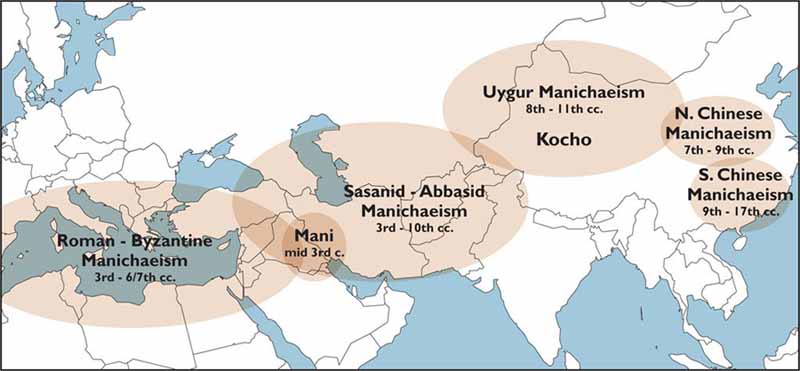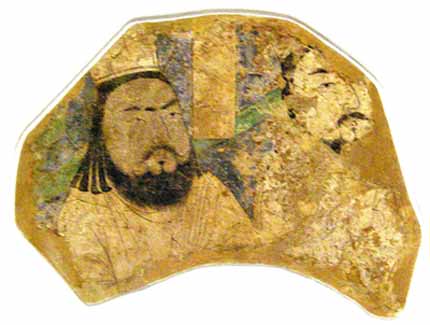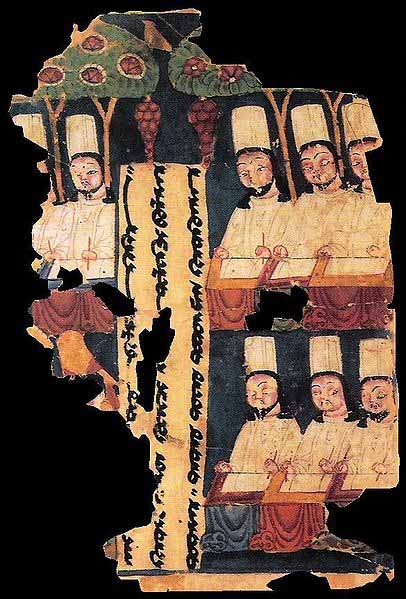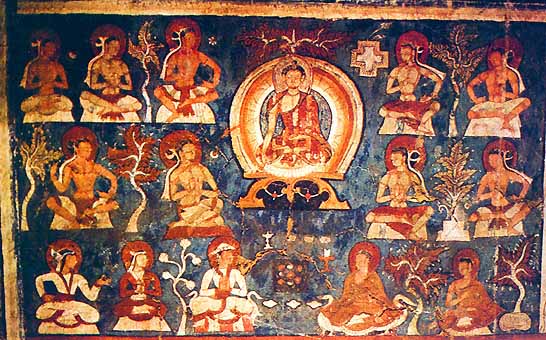

Manichaeism in Modern Persian was a major gnostic religion, originating in Sassanid era Babylonia. Although most of the original writings of the founding prophet Mani (c. 216-276 CE) have been lost, numerous translations and fragmentary texts have survived.
Manichaeism taught an elaborate cosmology describing the struggle between a good, spiritual world of light, and an evil, material world of darkness. Through an ongoing process which takes place in human history, light is gradually removed from the world of matter and returned to the world of light from which it came. Its beliefs, based on local Mesopotamian gnostic and religious movements, contained elements of Christianity, Zoroastrianism and Buddhism.
Manichaeism thrived between the third and seventh centuries, and at its height was one of the most widespread religions in the world. Manichaean churches and scriptures existed as far east as China and as far west as the Roman Empire. It was widespread among the legions of the Roman Empire, who considered it a soldier's religion, and it was briefly the main rival to Christianity in the competition to replace classical paganism. Manichaeism survived longer in the East than in the West, and it appears to have finally faded away after the 14th century in southern China, contemporary to the decline in China of the Church of the East.
Manichaeism is also referred to as Manicheanism (or Manichaeanism) and its adherents as Manicheans (or Manichaeans). By extension, the term "manichean" is widely applied (often disparagingly) as an adjective to a philosophy or attitude of moral dualism, according to which a moral course of action involves a clear (or simplistic) choice between good and evil, or as a noun to people who hold such a view.


Manicheism was a self-consciously missionary religion from the very beginning. The prophet Mani actively sought to deliver his message to a wide range of audiences in every part of the known world. The uniqueness of his revelation would thus be proved by his spectacular missionary successes. Mani himself undertook missionary journeys throughout the Sasanian Empire and to lands further east. He is known to have preached in India and was said to have converted the king of Turan (a country in northeastern Baluchistan). His disciples followed suit, called to a lifetime of travel and evangelism.
Mani, an Arsacid Iranian by birth, lived approximately AD 216-276 and was born in Babylonia, which was then within the Sassanid Empire province of Asuristan. According to the Cologne Mani-Codex, Mani's parents were members of the religious sect of Elcesaites.
The primary language of Babylon (and the administrative and cultural language of the Sassanid Empire) at that time was Eastern Middle Aramaic, which included three main dialects: Judeo-Aramaic (the language of the Talmud), Mandaean Aramaic (the language of the Mandaean religion), and Syriac Aramaic, which was the language of Mani, as well as of the Syriac Christians. "Mani" is a Sanskrit name used in all three Aramaic dialects and therefore common among their speakers.
Mani composed seven writings, six of which were written in Syriac Aramaic. The seventh, the Shabuhragan, was written by Mani in Middle Persian and presented by him to the contemporary King of Sassanid Persia, Shapur I in the Persian capital of Ctesiphon.
Although there is no proof Shapur I was a Manichaean, he tolerated the spread of Manicheanism and refrained from persecuting it in his empire's boundaries. According to one tradition it was Mani himself who invented the unique version of the Syriac script called Manichaean script, which was used in all of the Manichaean works written within the Persian Empire, whether they were in Syriac or Middle Persian, and also for most of the works written within the Uyghur Empire.
Manichaeism claimed to present the complete version of teachings that were corrupted and misinterpreted by the followers of its predecessors Adam, Zoroaster, Buddha and Jesus.
Accordingly, as it spread, it adapted new deities from other religions into forms it could use for its scriptures. Its original Aramaic texts already contained stories of Jesus. When they moved eastward and were translated into Iranian languages, the names of the Manichaean deities (or angels) were often transformed into the names of Zoroastrian yazatas.
Thus Abba deRabbuta ("The Father of Greatness", the highest Manichaean deity of Light), in Middle Persian texts might either be translated literally as pied wuzurgih, or substituted with the name of the deity Zurwan. Similarly, the Manichaean primal figure Nasa Qadmaya "The Original Man" was rendered "Ohrmazd Bay", after the Zoroastrian god Ahura Mazda.
This process continued in Manichaeism's meeting with Chinese Buddhism, where, for example, the original Aramaic karia (the "call" from the world of Light to those seeking rescue from the world of Darkness), becomes identified in the Chinese scriptures with Guan Yin literally, "watching/perceiving sounds of the world", the Chinese Bodhisattva of Compassion).
Mani began preaching at an early age and was possibly influenced by contemporary Babylonian-Aramaic movements such as Mandaeanism, and Aramaic translations of Jewish apocalyptic writings similar to those found at Qumran (such as the book of Enoch literature).
With the discovery of the Mani-Codex, it also became clear that he was raised in a Jewish-Christian baptism sect, the Elcesaites, and was influenced by their writings as well. According to biographies preserved by Ibn al-Nadim and the Persian polymath al-Biruni, he allegedly received a revelation as a youth from a spirit, whom he would later call his Twin (Aramaic Tauma, from which is also derived the name of the apostle Thomas, the "twin"), his Syzygos (Greek for "partner", in the Cologne Mani-Codex), his Double, his Protective Angel or 'Divine Self'. It taught him truths which he developed into a religion. His 'divine' Twin or true Self brought Mani to Self-realization and thus he became a 'gnosticus', someone with divine knowledge and liberating insight. He claimed to be the 'Paraclete of the Truth', as promised in the New Testament.
Manichaeism's views on Jesus are described by historians: "Jesus in Manichaeism possessed three separate identities (1) Jesus the Luminous, (2) Jesus the Messiah and (3) Jesus patibilis (the suffering Jesus).
(1) As Jesus the Luminous ... his primary role was as supreme revealer and guide and it was he who woke Adam from his slumber and revealed to him the divine origins of his soul and its painful captivity by the body and mixture with matter. Jesus the Messiah was a historical being who was the prophet of the Jews and the forerunner of Mani. However, the Manicheans believed he was wholly divine.
He never experienced human birth as notions of physical conception and birth filled the Manichaeans with horror and the Christian doctrine of virgin birth was regarded as equally obscene. Since he was the light of the world, where was this light, they asked, when he was in the womb of the Virgin? Jesus the Messiah was truly born at his baptism as it was on that occasion that the Father openly acknowledged his sonship.
The suffering, death and resurrection of this Jesus were in appearance only as they had no salvific value but were an exemplum of the suffering and eventual deliverance of the human soul and a prefiguration of Mani's own martyrdom.
(3) The pain suffered by the imprisoned Light-Particles in the whole of the visible universe, on the other hand, was real and immanent. This was symbolized by the 'mystic placing of the Cross whereby the wounds of the passion of our souls are set forth'. On this mystical Cross of Light was suspended the Suffering Jesus (Jesus patibilis) who was 'the life and salvation of Man.' This mystica cruxificio was present in every tree, herb, fruit, vegetable and even stones and the soil. This constant and universal suffering of the captive soul is exquisitely expressed in one of the Coptic Manichaean psalms"
Historians also note that Mani declared himself to be an "apostle of Jesus Christ" Also Manichaean tradition also is noted to have claimed that Mani was the reincarnation of different religious figures from Buddha, Lord Krishna, Zoroaster, and Jesus. "Other than incorporating the symbols and doctrine of dominant religious traditions, Manichaeism also incorporated the symbols and deities of indigenous traditions, in particular the Hindu deity Ganesha into its fold, demonstrated by the image available in the article, Manichaean art and calligraphy by Hans-Joachim Klimkeit. Mani was allegedly claiming to be the reincarnation of the Buddha, Lord Krishna, Zoroaster and Jesus depending on the context in which he was carrying out his preachings. Such strategic claims fostered a spirit of toleration among the Manicheans and the other religious communities and this particular feature greatly assisted them in gaining the approval of authorities to practice in different regions along the Silk Road."
Also academics note that since much of what is known about Manichaeism comes from later 10th and 11th Century CE Islamic historians like Al-Biruni and especially the Shia Muslim Persian historian Ibn al-Nadim (and his work Fihrist); "Islamic authors ascribed to Mani the claim to be the Seal of the Prophets" This topic is discussed by an Israeli academic Guy G. Stroumsa.
Another source of Mani's scriptures was original Aramaic writings relating to the book of Enoch literature - the Book of Enoch and the Second Book of Enoch), as well as an otherwise unknown section of the book of Enoch called the "Book of Giants".
The older sections (mainly in the Book of the Watchers) are estimated to date from about 300 BC, and the latest part (Book of Parables) probably was composed at the end of the 1st century BC.
It is wholly extant only in the Ge'ez language, with Aramaic fragments from the Dead Sea Scrolls and a few Greek and Latin fragments. The original language was either Aramaic or Hebrew; E. Isaac suggests that the Book of Enoch, like the Book of Daniel, was composed partially in Aramaic and partially in Hebrew.
A short section of 1 Enoch (1 En 1:9) is quoted in the New Testament (Letter of Jude 1:14-15), and is there attributed to "Enoch the Seventh from Adam" (1 En 60:8). It is argued that all the writers of the New Testament were familiar with it and were influenced by it in thought and diction.
This book was quoted directly, and expanded on by Mani, becoming one of the original six Syriac writings of the Manichaean Church. Besides brief references by non-Manichaean authors through the centuries, no original sources of "The Book of Giants" (which is actually part six of the "Book of Enoch") were available until the 20th century.
Scattered fragments of both the original Aramaic "Book of Giants" (which were analyzed and published by Jozef Milik in 1976), and of the Manichaean version of the same name (analyzed and published by W.B. Henning in 1943) were found with the discovery in the twentieth century of the Dead Sea Scrolls in the Judaean Desert and the Manichaean writings of the Uyghur Manichaean kingdom in Turpan. Henning wrote in his analysis of them:
It is noteworthy that Mani, who was brought up and spent most of his life in a province of the Persian empire, and whose mother belonged to a famous Parthian family, did not make any use of the Iranian mythological tradition. There can no longer be any doubt that the Iranian names of Sam, Nariman etc., that appear in the Persian and Sogdian versions of the Book of the Giants, did not figure in the original edition, written by Mani in the Syriac language.
From a careful reading of the Enoch literature and the Book of Giants, alongside the description of the Manichaean myth, it becomes clear that the "Great King of Glory" of this myth (a being that sits as a guard to the world of light at the seventh of ten heavens in the Manichaean myth), is identical with the King of Glory sitting on the heavenly throne in the Enoch literature. In the Aramaic book of Enoch, in the Qumran writings in general, and in the original Syriac section of Manichaean scriptures quoted by Theodor bar-Konai, he is called "malka raba de-ikara" (the great king of glory).
Noting Mani's travels to the Kushan Empire (several religious paintings in Bamiyan are attributed to him) at the beginning of his proselytizing career, Richard Foltz postulates Buddhist influences in Manichaeism:
Buddhist influences were significant in the formation of Mani's religious thought. The transmigration of souls became a Manichaean belief, and the quadripartite structure of the Manichaean community, divided between male and female monks (the "elect") and lay followers (the "hearers") who supported them, appears to be based on that of the Buddhist sangha.
While Manichaeism was spreading, existing religions such as Christianity and Zoroastrianism were gaining social and political influence. Although having fewer adherents, Manichaeism won the support of many high-ranking political figures. With the assistance of the Persian Empire, Mani began missionary expeditions. After failing to win the favour of the next generation of Persian royalty, and incurring the disapproval of the Zoroastrian clergy, Mani is reported to have died in prison awaiting execution by the Persian Emperor Bahram I. The date of his death is estimated at AD 276-277.

Manichaeism
The Mani Prayer wheel used for prayers in Tibetan Buddhism